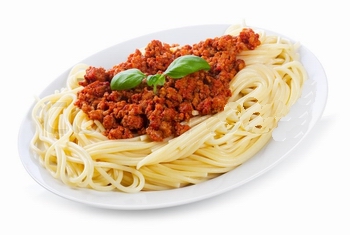|
Pasta is a staple food of traditional Italian
cuisine, with the first reference dating to 1154 in
Sicily. It is also commonly used to refer to the
variety of pasta dishes. Typically, pasta is a
noodle made from an unleavened dough of a durum
wheat flour mixed with water and formed into sheets
or various shapes, then cooked and served in any
number of dishes.
It can be made with flour from other cereals or
grains, and eggs may be used instead of water.
Pastas may be divided into two broad categories,
dried (pasta secca) and fresh (pasta fresca). |
|
 |
Most dried pasta is commercially produced via an extrusion
process. Fresh pasta was traditionally produced by hand,
sometimes with the aid of simple machines, but today many
varieties of fresh pasta are also commercially produced by
large-scale machines, and the products are widely available
in supermarkets.
Both dried and fresh pasta come in a number of shapes and
varieties, with 310 specific forms known variably by over
1300 names having been documented. In Italy the names of
specific pasta shapes or types often vary with locale. For
example the form cavatelli is known by 28 different names
depending on region and town. Common forms of pasta include
long shapes, short shapes, tubes, flat shapes and sheets,
miniature soup shapes, filled or stuffed, and specialty or
decorative shapes.
As a category in Italian cuisine, both fresh and dried
pastas are classically used in one of three kinds of
prepared dishes. As pasta asciutta (or pastasciutta) cooked
pasta is plated and served with a complementary sauce or
condiment. A second classification of pasta dishes is pasta
in brodo in which the pasta is part of a soup-type dish. A
third category is pasta al forno in which the pasta
incorporated into a dish that is subsequently baked.
Pasta is generally a simple dish, but comes in large
varieties because it is a versatile food item. Some pasta
dishes are served as a first course in Italy because the
portion sizes are small and simple. Pasta is also prepared
in light lunches, such as salads or large portion sizes for
dinner. It can be prepared by hand or food processor and
served hot or cold. Pasta sauces vary in taste, color and
texture. When choosing which type of pasta and sauce to
serve together, there is a general rule regarding
compatibility. Simple sauces like pesto are ideal for long
and thin strands of pasta while tomato sauce combines well
with thicker pastas. Thicker and chunkier sauces have the
better ability to cling onto the holes and cuts of short,
tubular, twisted pastas. The ratio of sauce to pasta varies
according to taste and texture, however traditionally the
sauce should not be excessive as the pasta itself should
still be tasted. The extra sauce left on the plate after all
of the pasta is eaten is often mopped up with a piece of
bread.
Etymology
First attested in English in 1874, the word pasta comes from
Italian pasta, in turn from Latin pasta "dough, pastry
cake", itself the latinisation of the Greek παστά (pasta)
"barley porridge", in turn from παστός (pastos), "sprinkled
with salt, salted".
History
Making pasta; illustration from the 15th century edition of
Tacuinum Sanitatis, a Latin translation of the Arabic work
Taqwīm al-sihha by Ibn Butlan.
In the 1st century BC writings of Horace, lagana (Sing.:
laganum) were fine sheets of fried dough and were an
everyday foodstuff. Writing in the 2nd century Athenaeus of
Naucratis provides a recipe for lagana which he attributes
to the 1st century Chrysippus of Tyana: sheets of dough made
of wheat flour and the juice of crushed lettuce, then
flavoured with spices and deep-fried in oil. An early 5th
century cookbook describes a dish called lagana that
consisted of layers of dough with meat stuffing, a possible
ancestor of modern-day lasagna. However, the method of
cooking these sheets of dough does not correspond to our
modern definition of either a fresh or dry pasta product,
which only had similar basic ingredients and perhaps the
shape. The first concrete information concerning pasta
products in Italy dates from the 13th or 14th century.
Historians have noted several lexical milestones relevant to
pasta, none of which changes these basic characteristics.
For example, the works of the 2nd century AD Greek physician
Galen mention itrion, homogeneous compounds made up of flour
and water. The Jerusalem Talmud records that itrium, a kind
of boiled dough, was common in Palestine from the 3rd to 5th
centuries AD, A dictionary compiled by the 9th century Arab
physician and lexicographer Isho bar Ali defines itriyya,
the Arabic cognate, as string-like shapes made of semolina
and dried before cooking. The geographical text of Muhammad
al-Idrisi, compiled for the Norman King of Sicily Roger II
in 1154 mentions itriyya manufactured and exported from
Norman Sicily |



